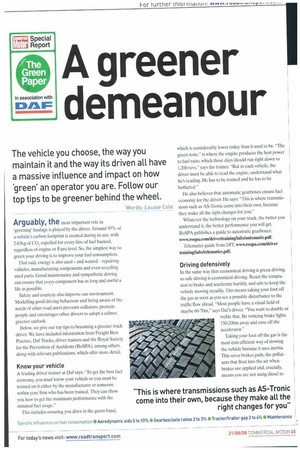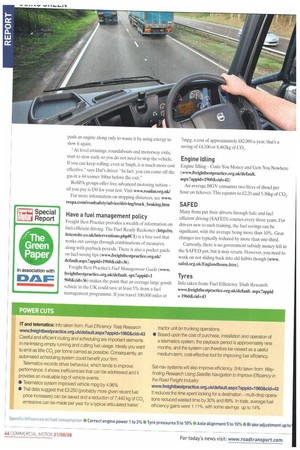A greener demeanour
Page 45

Page 46

If you've noticed an error in this article please click here to report it so we can fix it.
The vehicle you choose, the way you maintain it and the way its driven all have a massive influence and impact on how 'green' an operator you are. Follow our top tips to be greener behind the wheel.
Words: Louise Cole
Arguably, the most important role in 'greening' haulage is played by the driver. Around 95% of a vehicle's carbon footprint is created during its use, with 2.63kg of CO, expelled for every litre of fuel burned, regardless of engine or Euro level. So, the simplest way to green your driving is to improve your fuel consumption.
That said, energy is also used — and wasted — repairing vehicles, manufacturing components and even recycling used parts. Good maintenance and sympathetic driving can ensure that every component has as long and useful a life as possible.
Safety and courtesy also improve our environment. Modelling good driving behaviour and being aware of the needs of other road users prevents collisions, protects people and encourages other drivers to adopt a calmer, greener outlook.
Below, we give our top tips to becoming a greener truck driver. We have included information from Freight Best Practice, Daf Trucks, driver trainers and the Royal Society for the Prevention of Accidents (RoSPA), among others, along with relevant publications, which offer more detail.
Know your vehicle A leading driver trainer at Daf says: "To get the best fuel economy, you must know your vehicle so you must be trained on it either by the manufacturer or someone within your firm who has been trained. They can show you how to get the maximum performance with the minimal fuel usage."
This includes ensuring you drive in the green band, which is considerably lower today than it used to be. "The green zone," is where the engine produces the best power to fuel ratio, which these days should run right down to 1,200 revs," says the trainer. "But in each vehicle, the driver must he able to read the engine, understand what he's reading. He has to be trained and he has to be bothered."
He also believes that automatic gearboxes ensure fuel economy for the driver. He says: "This is where transmissions such as AS-Tronic come into their own, because they make all the right changes for you."
Whatever the technology on your truck, the better you understand it, the better performance you will get. RoSPA publishes a guide to automatic gearboxes: www.rospa.com/drivertraining/info/automatic.pdf.
Telematics guide from INT: www.rospa.com/driver trainingrmfo/telematics.pdf.
Driving defensively In the same way that economical driving is green driving, so safe driving is economical driving. Resist the temptation to brake and accelerate harshly, and aim to keep the vehicle moving steadily. This means taking your foot off the gas as soon as you see a possible disturbance to the traffic flow ahead. "Most people have a visual field of maybe 60-70m," says Daf's driver. "You want to double or treble that. Be noticing brake lights 150-200m away and ease off the accelerator."
Taking your foot off the gas is the most cost-efficient way of slowing the vehicle because it uses inertia. This saves brakes pads, the pollutants that float into the air when brakes are applied and, crucially, means you are not using diesel to push an engine along only to waste it by using energy to slow it again.
"At level crossings, roundabouts and motorway exits, start to slow early so you do not need to stop the vehicle. If you can keep rolling, even at 5mph, it is much more cost effective," says Daf's driver. "In fact, you can come off the gas in a 44-tonner 300m before the exit."
RoSPA groups offer free advanced motoring tuition all you pay is £50 for your test. Visit www.roadar.org.uk/ For more information on stopping distances, see www. rospa.com/roadsafety/advice/driving/truck_braking.htm
Have a fuel management policy
Freight Best Practice provides a wealth of information on fuel-efficient driving. The Fuel Ready Reckoner (hftp://rr. itstestsite.coAddinterventions.php#C1) is a free tool that works out savings through combinations of measures, along with payback periods. There is also a pocket guide on fuel-saving tips (www.freightbestpractice.org.uk/ defaultaspx?appid.1960&lid=36).
Freight Best Practice's Fuel Management Guide (www. freightbestpractice.org.uk/default. spx?appid=1 960&cid=36) makes the point that an average large goods vehicle in the UK could save at least 5% from a fuel management programme. If you travel 100,000 miles at 7mpg, a cost of approximately £82,000 a year, that's a saving of £4,100 or 8.462kg of COz.
Engine Idling
Engine Idling Costs You Money and Gets You Nowhere (www.freightbestpractice.org.uk/defauh. aspx?appid=1960&cid.42) An average HGV consumes two litres of diesel per hour on tickover. This equates to £2.20 and 5.36kg of CO2.
SAFED
Many firms put their drivers through Safe and fuel efficient driving (SAFED) courses every three years. For drivers new to such training, the fuel savings can be significant, with the average being more than 10%. Gear changes are typically reduced by more than one-third.
Currently, there is no government subsidy money left in the SAFED pot, hut it may return. However, you need to work on not sliding back into old habits though (www. safed.org.uk/Ertglandhome.htm).
Tyres
Info taken from: Fuel Efficiency Trials Research wwvv.freightbestpractice.org.uk/default. aspx?appid 1960&cid=43












































































































































































